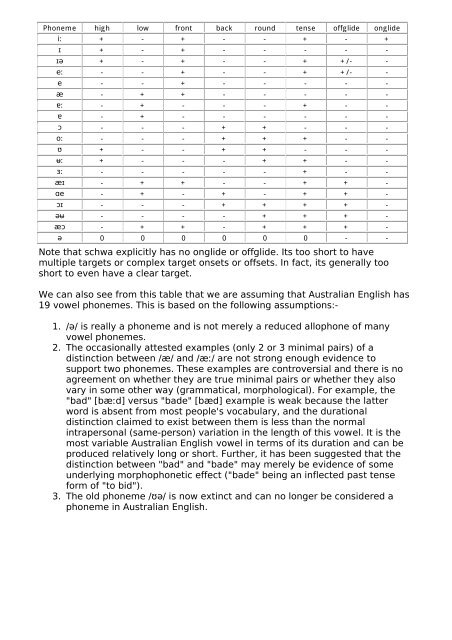Distinctive Features - Speech Resource Pages - Macquarie University
Distinctive Features - Speech Resource Pages - Macquarie University
Distinctive Features - Speech Resource Pages - Macquarie University
You also want an ePaper? Increase the reach of your titles
YUMPU automatically turns print PDFs into web optimized ePapers that Google loves.
Phoneme high low front back round tense offglide onglide<br />
iː + - + - - + - +<br />
ɪ + - + - - - - -<br />
ɪə + - + - - + +/- -<br />
eː - - + - - + +/- -<br />
e - - + - - - - -<br />
æ - + + - - - - -<br />
ɐː - + - - - + - -<br />
ɐ - + - - - - - -<br />
ɔ - - - + + - - -<br />
oː - - - + + + - -<br />
ʊ + - - + + - - -<br />
ʉː + - - - + + - -<br />
ɜː - - - - - + - -<br />
æɪ - + + - - + + -<br />
ɑe - + - + - + + -<br />
ɔɪ - - - + + + + -<br />
əʉ - - - - + + + -<br />
æɔ - + + - + + + -<br />
ə 0 0 0 0 0 0 - -<br />
Note that schwa explicitly has no onglide or offglide. Its too short to have<br />
multiple targets or complex target onsets or offsets. In fact, its generally too<br />
short to even have a clear target.<br />
We can also see from this table that we are assuming that Australian English has<br />
19 vowel phonemes. This is based on the following assumptions:-<br />
1. /ə/ is really a phoneme and is not merely a reduced allophone of many<br />
vowel phonemes.<br />
2. The occasionally attested examples (only 2 or 3 minimal pairs) of a<br />
distinction between /æ/ and /æː/ are not strong enough evidence to<br />
support two phonemes. These examples are controversial and there is no<br />
agreement on whether they are true minimal pairs or whether they also<br />
vary in some other way (grammatical, morphological). For example, the<br />
"bad" [bæːd] versus "bade" [bæd] example is weak because the latter<br />
word is absent from most people's vocabulary, and the durational<br />
distinction claimed to exist between them is less than the normal<br />
intrapersonal (same-person) variation in the length of this vowel. It is the<br />
most variable Australian English vowel in terms of its duration and can be<br />
produced relatively long or short. Further, it has been suggested that the<br />
distinction between "bad" and "bade" may merely be evidence of some<br />
underlying morphophonetic effect ("bade" being an inflected past tense<br />
form of "to bid").<br />
3. The old phoneme /ʊə/ is now extinct and can no longer be considered a<br />
phoneme in Australian English.
















